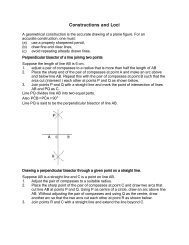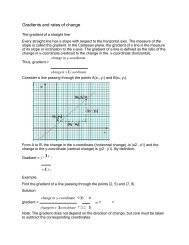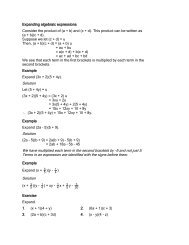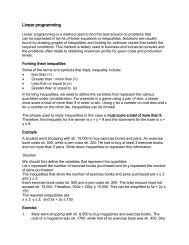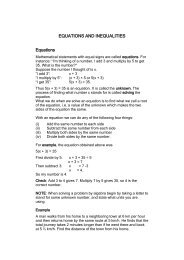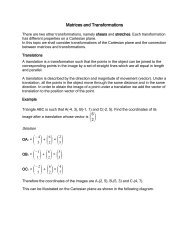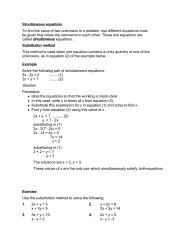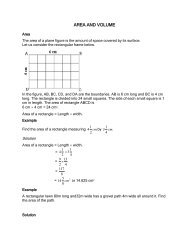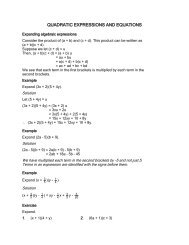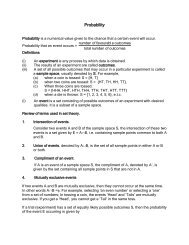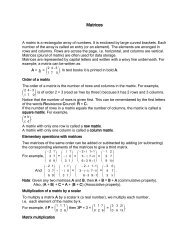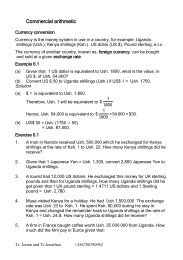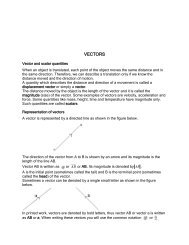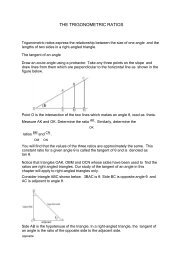J26
You also want an ePaper? Increase the reach of your titles
YUMPU automatically turns print PDFs into web optimized ePapers that Google loves.
Trigonometry (2)<br />
Triangle PQR in the figure below is right-angled and PQR = θ.<br />
In the figure, PQ is the hypotenuse; PR is the opposite side to θ. In general:<br />
opposite side PR<br />
Sin θ = =<br />
hypotenuse<br />
adjacent side<br />
Cos θ = =<br />
hypotenuse<br />
opposite side<br />
Tan θ = = .<br />
PQ<br />
QR<br />
PQ<br />
PR<br />
QR<br />
adjacent side<br />
Tan θ =
Angles of 45 0 , 60 0 and 30 0<br />
Tan, sin and cos of 45 0<br />
Consider an isosceles right-angled triangle ABC such that AB = BC = 1 unit and B =<br />
90 0<br />
= 2 (Pythagoras’ theorem) Therefore, AC<br />
Since AB = BC, A = C =<br />
1<br />
= 1; sin 45 0 2<br />
45 0<br />
1<br />
= ; cos 45 0 = 2<br />
Tan, sin and cos of 60 0 and 30 0<br />
Consider an equilateral triangle ABC whose sides are 2 cm as shown in the diagram<br />
below. AN is its perpendicular height.<br />
Using Pythagoras’ theorem, we have<br />
BN 2 + AN 2 = 2 2<br />
1 + AN 2 = 4<br />
= 3 Therefore,
3 0 = 3 = √ 3.<br />
Sin 60 0 = 2 ; cos 60 0 = and 1 tan 60<br />
3<br />
1<br />
Sin 30 0 = ; cos 30 0 = 2 and tan 30 0 = 3<br />
Example<br />
1<br />
If cos θ = 2 , where θ is acute, without using tables or calculator, find:<br />
(a) sin θ (b) tan θ.<br />
(c) cos θ + tan θ. Leave your answers in surd form.<br />
Solution<br />
(a) Consider ∆ABC right-angled at B. Using Pythagoras’ theorem,<br />
AB 2 + BC 2 = AC 2<br />
1<br />
AB 2 + 1 2 = (√2) 2<br />
AB 2 = 2 – 1 =
The graph of y = sin x (Sine Curve)<br />
To draw the graph of y = sin x, first, prepare a table of values of x and y. Choose<br />
suitable values of x in the interval 0 ≤ x ≤ 720 0 and then find the corresponding values<br />
of y. The table below shows the values of y = sin x in the interval 0 ≤ x ≤ 720 0 .<br />
x 0 90 180 270 360 450 540 630 720<br />
y =<br />
0 1 0 -1 0<br />
-1 0<br />
sin x<br />
1 0<br />
Plot the ordered pairs (x, y) on a graph paper and join the points with a smooth curve.<br />
The diagram below shows the graph of y = sin x, in the interval 0 ≤ x ≤ 720 0<br />
The graph of sine curve, y = sin x, shown above illustrates that:<br />
(i)<br />
The sine curve is a wave which lies between -1 and +1; it is zero at multiples of<br />
180 0 , -1 ≤ sin x ≤ 1<br />
(ii) The graph repeats itself at intervals of 360 0 .<br />
(iii) For any value of sin x in the range -1 to +1, there are two corresponding values of x<br />
in the domain 0 ≤ x ≤ 360 0 . (Except when sin x = -1, 0 and 1).<br />
The graph of y = cos x<br />
The table below shows the values of y = cos x in the interval 0 ≤ x ≤ 360 0<br />
x 0 60 90 120 180 240 270 300 360<br />
y = cos<br />
x<br />
1 0.5 0 -0.5 -1 -0.5 0 0.5<br />
1<br />
Plot the ordered pairs (x, cos x) on the graph and join them to obtain the required curve<br />
as shown below.
The sine rule<br />
The sine rule enables us to calculate sides and angles in some triangles where there is<br />
not a right angle. It is used when:<br />
(i)<br />
one side and two angles are known or<br />
(ii) two sides and an angle (opposite to one of the two sides) are known.<br />
In ∆ABC, we use the convention that<br />
the side opposite A b is<br />
opposite B<br />
ˆ a is<br />
ˆ the side<br />
c is the side opposite Cˆ<br />
In any triangle ABC, the sine rule states that<br />
b c<br />
= =<br />
a<br />
………….. (i) sin A sinB sinC
Sin A Sin B Sin C<br />
Or = = ……………..(ii) a b c<br />
Use (i) when finding a side, and (ii) when finding an angle.<br />
Example<br />
ˆ<br />
Find B .<br />
Solution<br />
Sin B Sin ASin B Sin120 0<br />
=<br />
= b a6 15<br />
Sin B =
Bˆ = 20.3 0
7. In triangle ABC, Aˆ = 61 0 , Bˆ = 47 0 , AC = 7.2 cm. Find BC.<br />
8. In ∆XYZ, Zˆ =32 0 , Yˆ =78 0 , XY = 5.4 cm. Find XZ.
9. In ∆PQR, Qˆ =100 0 , Rˆ =21 0 , PQ = 3.1 cm. Find PR.<br />
10. In ∆LMN, Lˆ =21 0 , Nˆ =30 0 , MN = 7 cm. Find LN.<br />
11. In ∆ABC, Aˆ =62 0 , BC = 8 cm, AB = 7 cm. Find Cˆ .<br />
12. In ∆XYZ, Yˆ =97.3 0 , XZ = 22, XY = 14. Find Zˆ<br />
13. In ∆DEF, Dˆ =58 0 , EF = 7.2, DE = 5.4. Find Fˆ .<br />
14. In ∆LMN, Mˆ =127.1 0 , LN = 11.2, LM = 7.3. Find Lˆ .<br />
The Cosine Rule<br />
We use the cosine rule when we have either (a)<br />
two sides and the included angle or (b) all three<br />
sides.<br />
There are two forms:<br />
1. To find the length of a side:<br />
a 2 =b 2 +c 2 - 2bc cos A or b 2 = a 2 +<br />
c 2 – 2ac cos B or c 2 = a 2<br />
+ b 2 – 2ab cos C<br />
2. To find an angle when given all<br />
three sides.<br />
a 2 b 2<br />
c 2<br />
b 2 c 2 a 2 a 2 c 2 b 2<br />
cos A or cosB or cosC
2bc 2ac<br />
2ab<br />
Example<br />
Find b. Solution b 2 = a 2<br />
+ c 2 – 2ac cos B<br />
= 64 + 25 – (2 × 8 × 5 × cos 112 0 )<br />
0.3746)) = 64 + 25 + 29.968 b
The area of a triangle<br />
For any triangle,<br />
Area = half the product of any two sides and the sine of the included angle.<br />
= ac sin B or bc sin A or ab sin C<br />
Example
Find the area of a triangle ABC in which a = 4.2 cm, c = 7.5 cm, and B = 110 0 .<br />
Exercise<br />
Area =<br />
ac sin B<br />
= × 4.2 × 7.5 × sin 110 0<br />
= 2.1 × 7.5 × sin 110 0<br />
2<br />
= 14.8 cm .
8. a = 4 cm, b = 7 cm and C = 42.5 0 . Find C, A and B.<br />
9. a = 7 cm, b = 8 cm and c = 6 cm. Find the angles of the triangles<br />
10. a = 4 cm, b = 5 cm and C = 120 0 . Find c, A and B.<br />
11. b = 10 cm, c = 12 cm and c = 20 cm. Find angle C<br />
12. b = 10 cm, c = 12 cm and A = 130 0 . Find a, B and C<br />
13. In ∆PQR, q = 3 cm, r = 5 cm and P = 120 0 . Find p and also the area of the triangle.<br />
14. In ∆ABC, b = 3 cm, c = b and A = 50 0 . Find a, C and B.<br />
15. In ∆ABC, a = 5 cm, b = 7 cm and c = 9 cm. Calculate the angle B and the area of<br />
the triangle.<br />
16. In ∆ABC, AB = 3 cm, BC = 4 cm and angle B = 40 0 . Calculate the area of the<br />
triangle and the length of the third side.<br />
17. In ∆ABC, a = 3 cm, b = 5 cm and angle A = 20 0 . Calculate the two possible values<br />
of the angle B.
18. The diagonals of a parallelogram ABCD intersect at O, where angle<br />
AOB = 45 0 . Find the area of the parallelogram, if the diagonal AC = 7.2 cm and the<br />
diagonal BD = 5.6 cm.<br />
19. In the figure below, AB = 8 cm, BD = 20 cm, DC = 14 cm, angle BDC = 90 0 and<br />
angle ABC = 76 0 .<br />
(a)<br />
(b)<br />
Calculate:<br />
the size of the angle ABD,<br />
area of the quadrilateral ABCD.<br />
Exercise<br />
1. PQRS is a trapezium in which PQ is parallel to SR. The diagonal<br />
SQ = 5 cm, RS = 7 cm and angle RSQ = 26 0 . Calculate the length of QR and the<br />
area of triangle QSR. Given also that PS = QR, calculate angle SPQ.<br />
2. A point X is 10 nautical miles due north of Y. The bearing of a ship S from X is 140 0<br />
and that from Y is 080 0 . Calculate the distance of the ship from X.<br />
3. ABC is a triangle whose base BC = 35 cm. The point X on BC is such that BX = 21<br />
cm, AX = 16 cm and angle AXB = 60 0 . Calculate:<br />
(a) the length of AB, (b) the length of AC, (c) the size of angle BAC.<br />
4. The point P is 5 km due north of the point Q. A man walks from Q in a direction<br />
030 0 . Calculate how far he walks before he is<br />
(a) equidistant from P and Q, (b) as close as possible to P and (c) north<br />
east of P.<br />
5. P is a point on the coast 1.5 km due east of a guard station C. S is another point on<br />
the coast 2.7 km from C. A ship sailing from P to S is intercepted at Q by a boat<br />
from the coast guard station. Given that angle PCS = 63 0 and QS = 0.5 km,<br />
calculate: (a) PQ,<br />
(b) the bearing of Q from P.
6. A destroyer D and a cruiser C leave port P at the same time. The destroyer sails 25<br />
km on a bearing 040 0 and the cruiser sails 30 km on a bearing of 320 0 . How far<br />
apart are the ships?<br />
7. Find all the angles of a triangle in which the sides are in the ratio 5 : 6 : 8<br />
8. From A, B lies 11 km away on a bearing of 041 0 and C lies 8 km away on a bearing<br />
of 341 0 . Find:<br />
(a) the distance between B and C (b) the bearing of B from C.<br />
9. From a lighthouse L an aircraft carrier A is 15 km away on a bearing of 112 0 and a<br />
submarine S is 26 km away on a bearing of 200 0 . Find: (a) the distance<br />
between A and S, (b) the bearing of A from S.<br />
10. If the line BCD is horizontal find:<br />
(a)<br />
(b)<br />
AE<br />
EAˆC<br />
(c) the angle of elevation of E from A.<br />
11. An aircraft flies from its base 200 km on a bearing 162 0 , then 350 km on a bearing<br />
260 0 , and then returns directly to base. Calculate the length and bearing of the<br />
return journey.<br />
12. Town Y is 9 km due north of town Z. Town X is 8 km from Y, 5 km from Z and<br />
somewhere to the west of the line YZ.<br />
(a)<br />
Draw triangle XYZ and find angle YZX.<br />
(b) During an earthquake, town X moves due South until it is due West of Z.<br />
Find how far it has moved.
13.<br />
Calculate WX, given YZ = 15 m.



